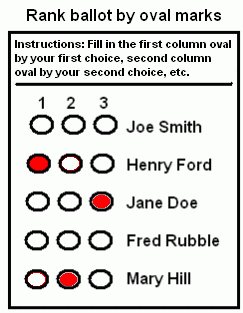It is possible to estimate the probability of the paradox by extrapolating from real election data, or using mathematical models of voter behavior, though the results depend strongly on which model is used.
Impartial culture model
We can calculate the probability of seeing the paradox for the special case where voter preferences are uniformly distributed among the candidates. (This is the "impartial culture" model, which is known to be a "worst-case scenario" [4] [5] : 40 [6] : 320 [7] —most models show substantially lower probabilities of Condorcet cycles.)
For  voters providing a preference list of three candidates A, B, C, we write
voters providing a preference list of three candidates A, B, C, we write  (resp.
(resp.  ,
,  ) the random variable equal to the number of voters who placed A in front of B (respectively B in front of C, C in front of A). The sought probability is
) the random variable equal to the number of voters who placed A in front of B (respectively B in front of C, C in front of A). The sought probability is  (we double because there is also the symmetric case A> C> B> A). We show that, for odd
(we double because there is also the symmetric case A> C> B> A). We show that, for odd  ,
,  where
where  which makes one need to know only the joint distribution of
which makes one need to know only the joint distribution of  and
and  .
.
If we put  , we show the relation which makes it possible to compute this distribution by recurrence:
, we show the relation which makes it possible to compute this distribution by recurrence:  .
.
The following results are then obtained:
 | 3 | 101 | 201 | 301 | 401 | 501 | 601 |
|---|
 | 5.556% | 8.690% | 8.732% | 8.746% | 8.753% | 8.757% | 8.760% |
The sequence seems to be tending towards a finite limit.
Using the central limit theorem, we show that  tends to
tends to  where
where  is a variable following a Cauchy distribution, which gives
is a variable following a Cauchy distribution, which gives  (constant quoted in the OEIS).
(constant quoted in the OEIS).
The asymptotic probability of encountering the Condorcet paradox is therefore  which gives the value 8.77%. [8] [9]
which gives the value 8.77%. [8] [9]
Some results for the case of more than three candidates have been calculated [10] and simulated. [11] The simulated likelihood for an impartial culture model with 25 voters increases with the number of candidates: [11] : 28
| 3 | 4 | 5 | 7 | 10 |
|---|
| 8.4% | 16.6% | 24.2% | 35.7% | 47.5% |
The likelihood of a Condorcet cycle for related models approach these values for three-candidate elections with large electorates: [9]
All of these models are unrealistic, and are investigated to establish an upper bound on the likelihood of a cycle. [9]
Spatial model
A study of three-candidate elections analyzed 12 different models of voter behavior, and found the spatial model of voting to be the most accurate to real-world ranked-ballot election data. Analyzing this spatial model, they found the likelihood of a cycle to decrease to zero as the number of voters increases, with likelihoods of 5% for 100 voters, 0.5% for 1000 voters, and 0.06% for 10,000 voters. [12]
Another spatial model found likelihoods of 2% or less in all simulations of 201 voters and 5 candidates, whether two or four-dimensional, with or without correlation between dimensions, and with two different dispersions of candidates. [11] : 31
Empirical studies
Many attempts have been made at finding empirical examples of the paradox. [13] Empirical identification of a Condorcet paradox presupposes extensive data on the decision-makers' preferences over all alternatives—something that is only very rarely available.
While examples of the paradox seem to occur occasionally in small settings (e.g., parliaments) very few examples have been found in larger groups (e.g. electorates), although some have been identified. [14]
A summary of 37 individual studies, covering a total of 265 real-world elections, large and small, found 25 instances of a Condorcet paradox, for a total likelihood of 9.4% [6] : 325 (and this may be a high estimate, since cases of the paradox are more likely to be reported on than cases without). [5] : 47
An analysis of 883 three-candidate elections extracted from 84 real-world ranked-ballot elections of the Electoral Reform Society found a Condorcet cycle likelihood of 0.7%. These derived elections had between 350 and 1,957 voters. A similar analysis of data from the 1970–2004 American National Election Studies thermometer scale surveys found a Condorcet cycle likelihood of 0.4%. These derived elections had between 759 and 2,521 "voters". [12]
A database of 189 ranked United States election from 2004 to 2022 contained only one Condorcet cycle: the 2021 Minneapolis Ward 2 city council election. [15] While this indicates a very low rate of Condorcet cycles (0.5%), it's possible that some of the effect is due to general two-party domination.
Andrew Myers, who operates the Condorcet Internet Voting Service, analyzed 10,354 nonpolitical CIVS elections and found cycles in 17% of elections with at least 10 votes, with the figure dropping to 2.1% for elections with at least 100 votes, and 1.2% for ≥300 votes. [16]





















